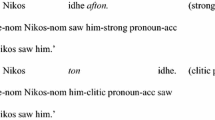Abstract
Language samples from matched groups of 80 autistic, mentally handicapped, and normally developing children were coded for the presence of neologisms and/or idiosyncratic language use. Cognitive, social, or linguistic factors that might account for these errors were identified and assessed. More autistic subjects used neologisms and idiosyncratic language than age- and language skill-matched control groups. No single factor or combination of factors was responsible for this difference. Across diagnostic groups, similar patterns of error were noted, except that the autistic subjects were more likely to use words inappropriately that had no phonological or semantic similarity to the intended English word. For the autistic groups, the frequency of idiosyncratic language increased with language complexity. In contrast, such errors decreased with language skill in the mentally handicapped group. Theoretical implications for determining the nature and source of the language disorder associated with autism are discussed.
Similar content being viewed by others
References
American Psychiatric Association. (1987).Diagnostic and statistical manual of mental disorders (3rd ed., rev.). Washington, DC: Author.
Baltaxe, C. A. M., & Simmons, J. Q. (1983). Communication deficits in the adolescent and adult autistic.Seminars in Speech and Language, 4, 27–42.
Baron-Cohen, S., Leslie, A. M., & Frith, U. (1985). Does the autistic child have a ‘theory of mind’?Cognition, 21, 37–46.
Bartak, L., Rutter, M., & Cox, A. (1975). A comparative study of infantile autism and specific developmental receptive language disorder: I: The children.British Journal of Psychiatry, 126, 127–145.
Bartolucci, G., Pierce, S., Streiner, D., & Tolkin-Eppel, P. (1976). Phonological investigation of verbal autistic and mentally retarded subjects.Journal of Autism and Childhood Schizophrenia, 6, 303–315.
Brown, R. (1973).A first language. Cambridge, MA: Harvard University Press.
Cantwell, D. P., Baker, L., & Rutter, M. (1978). A comparative study of infantile autism and specific developmental receptive language disorder: IV. Analysis of syntax and language function.Journal of Child Psychology and Psychiatry, 19, 351–363.
Cohen, D. J., Caparulo, B. K., Gold, J. R., Waldo, M. C., Shaywitz, B., Ruttenberg, B. A., & Rimland, B. (1978). Agreement in diagnosis: Clinical assessment and behavior rating scales for pervasively disturbed children.Journal of the American Academy of Child Psychiatry, 17, 589–603.
Fein, D., Humes, M., Kaplan, E., Lucci, D., Waterhouse, L. (1984). The question of left hemisphere dysfunction in infantile autism.Psychological Bulletin, 95, 258–281.
Fein, D., Skoff, B., & Mirsky, A. F. (1981). Clinical correlates of brain dysfunction in autistic children.Journal of Autism and Developmental Disorders, 11, 303–316.
Howlin, P. (1984). The acquisition of grammatical morphemes in autistic children: A critique and replication of the findings of Bartolucci, Pierce, and Streiner, 1980.Journal of Autism and Developmental Disorders, 14, 127–136.
Kanner, L. (1946). Irrelevant and metaphorical language.American Journal of Psychiatry, 103, 242–246.
Le Couteur, A., Rutter, M., Lord, C., Rios, P., Robertson, S., Holdgrafer, M., & McLennan, J. D. (1989). Autism Diagnostic Interview: A semi-structured interview for parents and caregivers of autistic persons.Journal of Autism and Developmental Disorders, 19, 363–387.
Lord, C., Rutter, M., Goode, S., Heemsbergen, J., Jordan, H., Mawhood, L., Schopler, E. (1989). Autism Diagnostic Observation Schedule: A standardized observation of communicative and social behavior.Journal of Autism and Developmental Disorders, 19, 185–212.
Miller, J., & Chapman, R. (1983).Systematic analysis of language transcripts. Madison: University of Wisconsin, Waisman Center.
Mundy, P., Sigman, M., Ungerer, J., & Sherman, T. (1986). Defining the social deficits of autism: The contribution of nonverbal communication measures.Journal of Child Psychology and Psychiatry, 27, 657–669.
Rutter, M. (1965). Speech disorders in a series of autistic children. In A. Franklin (Ed.),Children with communication problems (pp. 39–47). London: Pitman.
Rutter, M. (1978). Language disorder and development. In M. Rutter & E. Schopler (Eds.),Autism: A reappraisal of concepts & treatment (pp. 85–104). New York: Plenum Press.
Rutter, M. (1983). Cognitive deficits in the pathogenesis of autism.Journal of Child Psychology and Psychiatry, 24, 513–532.
Schopler, E., Reichler, R. J., & Renner, B. R. (1986).The Childhood Autism Rating Scale (CARS) for diagnostic screening and classification of autism. New York: Irvington Publishers.
Sigman, M., Mundy, P., Sherman, T., & Ungerer, J. (1986). Social interactions of autistic, mentally retarded and normal children and their caregivers.Journal of Child Psychology and Psychiatry, 27, 647–656.
Tager-Flusberg, H. (1981). On the nature of linguistic functioning in early infantile autism.Journal of Autism and Developmental Disorders, 11, 45–56.
Tager-Flusberg, H. (1985). Psycholinguistic approaches to language and communication in autism. In E. Schopler & G. Mesibov (Eds.),Communication problems in autism (pp. 69–87). New York: Plenum Press.
Tager-Flusberg, H. (1987). On the nature of a language acquisition disorder: The example of autism. In F. Kessel (Ed.),The development of language and language researchers (Essays in honor of Roger Brown) (pp. 249–267). Hillsdale, NJ: Erlbaum.
Ungerer, J. A. (1989). The early development of autistic children: Implications for defining primary deficits. In G. Dawson (Ed.),Autism: Nature, diagnosis and treatment (pp. 75–91). New York: Guilford.
Volkmar, F. R. (1987). Diagnostic issues in the pervasive developmental disorders.Journal of Child Psychology and Psychiatry, 28, 365–369.
Waterhouse, L., & Fein, D. (1982). Language skills in developmentally disabled children.Brain and Language, 15, 307–333.
Wechsler, D. (1974).Wechsler Intelligence Scale for Children-Revised. New York: Psychological Corp.
Wechsler, D. (1981).Wechsler Adult Intelligence Scale-Revised. New York: Psychological Corp.
World Health Organization. (1987).ICD-10 1986 draft of chapter 5 categories F00-F99. Mental, behavioural and developmental disorders. Geneva: Author.
Author information
Authors and Affiliations
Additional information
The authors acknowledge the assistance in transcription and coding of Cathy Mulloy, Lynn Anderson-Cook, Heather Jordan, and Sharon Storoschuk, and the financial support of NSERC grant 5547740, and AHFMR grant 04764, held by the second author.
Rights and permissions
About this article
Cite this article
Volden, J., Lord, C. Neologisms and idiosyncratic language in autistic speakers. J Autism Dev Disord 21, 109–130 (1991). https://doi.org/10.1007/BF02284755
Issue Date:
DOI: https://doi.org/10.1007/BF02284755




